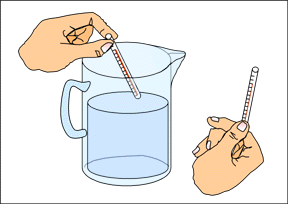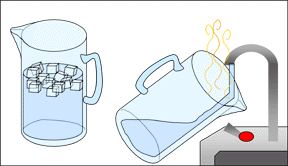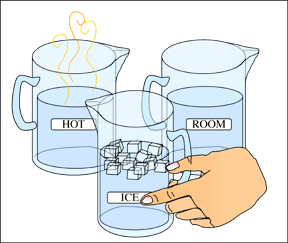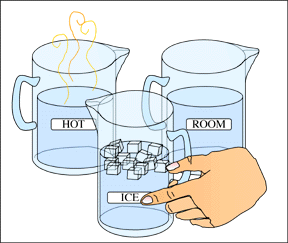 |
 |
|
|
|
|
Contributed by: Kentucky Department of Education (KDE) Description:In this task students will measure the temperatures of three cups of water in degrees Celsius, record temperatures in a chart and graph the results. Students then relate cooling and warming to surrounding temperature, and apply the concepts of cooling and warming to everyday events.Groups of students will work with three cans of water; one at room temperature, one hot, and one ice cold. They will observe the cooling and warming of the hot and cold cans by measuring the change of temperature over time and comparing them to the water that began at room temperature. They will record their measurements in a table and graph the results. As individuals, they will attempt to develop explanations for the observations made and apply their findings to actual situations. This task is designed to take students approximately 45 minutes to complete.
Overall Task Content Area:
Specific Knowledge Areas:
Performance Expectations:
National Science Education Standards:4 A SI 1: Abilities necessary to do scientific inquiry: Grades K-41.3 Employ simple equipment and tools to gather data and extend the senses. In early years, students develop simple skills, such as how to observe, measure, cut, connect, switch, turn on and off, pour, hold, tie, and hook. Beginning with simple instruments, students can use rulers to measure the length, height, and depth of objects and materials; thermometers to measure temperature; watches to measure time; beam balances and spring scales to measure weight and force; magnifiers to observe objects and organisms; and microscopes to observe the finer details of plants, animals, rocks, and other materials. Children also develop skills in the use of computers and calculators for conducting investigations. 1.4 Use data to construct a reasonable explanation. This aspect of the standard emphasizes the studentsí thinking as they use data to formulate explanations. Even at the earliest grade levels, students should learn what constitutes evidence and judge the merits or strength of the data and information that will be used to make explanations. After students propose an explanation, they will appeal to the knowledge and evidence they obtained to support their explanations. Students should check their explanations against scientific knowledge, experiences, and observations of others. 4 B PS 3: Light, heat, electricity, and magnetism: Grades
K-4 (Use the "hot" link on the PALS home page to check the full text of related National Science Education Standards, if desired.)
National Council of Teachers of Mathematics:AL4: Analyze change in various contexts:Grades pre K-5 b. describe quantitative change, such as a student’s growing two inches in one year DAP1: Formulate questions that can
be addressed with data and collect, organize, and display relevant
data to answer them: DAP3: Develop and evaluate inferences
and predictions that are based on data: MEAS1: Understand measurable attributes of objects and
the units, systems, and processes of measurement: MEAS2: Apply appropriate techniques, tools, and formulas
to determine measurements: PS1: Build new mathematical knowledge through problem
solving: RP3: Develop and evaluate mathematical arguments and
proofs: REP3: Use representations to model and interpret physical,
social, and mathematical phenomena: Students may work in groups of 4 (3-5) for the experiment/activity part of this exercise. Students work together for up to 30 minutes. They are instructed to notify you when finished with the group work, and then to go on to the individual work. If students are still working together 30 minutes after the testing begins, instruct them to cease their group work and begin individual work. At this point, they may no longer talk. Whether or not they are just beginning their individual work, remind students that they now have about 15 minutes to complete the individual activity. Students should be ready to work as soon as the period begins. Group assignments should be made in advance. The materials should be set out at each lab station, if possible. A central supply area, if needed, should be easily accessible. All supplies should be clearly labeled.
At this station students should have:
Water at correct temperatures must be prepared before the testing period. Use ice and hot water from school sources. Room temperature water can be prepared by mixing hot and cold water while measuring the water temperature, or a supply of water can be left out in the same room where the test will be given for at least 30 minutes prior to the test period. This temperature MUST be the same as the temperature in the room which is easily measured by leaving one of the thermometers in air for a while. Safety:
Extensions/modifications:
Advanced Preparation Set Up:
|



